Texans are great people, I like them a lot, they're very friendly and very quick to ask "where are y'all from?" and then strike up a conversation. But you could forgive them for being not quite so laid-back, welcoming and friendly, because the whole state is doing it tough, with a long and disastrous drought making life harder and less prosperous for virtually everyone. What they need is one of those Caribbean tropical storms to fall short of being a hurricane and turn into a big, slow-moving rain depression that dumps a dozen or two inches of rain all over the parched earth over the course of 10 or so days. Everyone hopes this will happen soon, and I won't be complaining if it washes out a few days of our travels. Texas needs rain!
So, we knew all about the drought by the time we arrived in Austin, but that didn't stop us visiting the local Zilker Botanical Gardens. We knew they wouldn't be at their best – in fact they'd probably be at their worst – and so it's a tribute to the good, basic bones of these fine gardens that they still looked so good. Here are some photos of our day at the gardens, but I thought it would be only appropriate to start with the plants which barely know there is a drought on, the cacti and succulents.
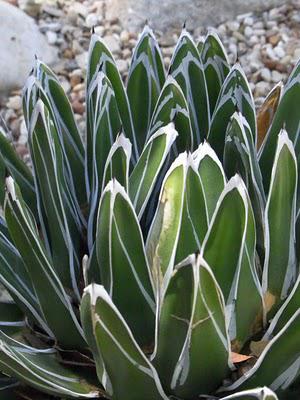 You won't get many plant names out of me here because I don't know them, just a few short notes where there's something to note, such as the superb variegated foliage on this succulent.
You won't get many plant names out of me here because I don't know them, just a few short notes where there's something to note, such as the superb variegated foliage on this succulent.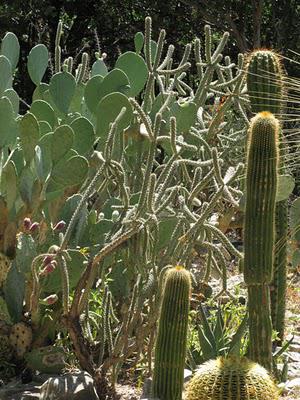 What surprised me at the Zilker was the size of the cactus and succulent garden. It's tiny, but it makes up for that with some interesting specimens.
What surprised me at the Zilker was the size of the cactus and succulent garden. It's tiny, but it makes up for that with some interesting specimens. 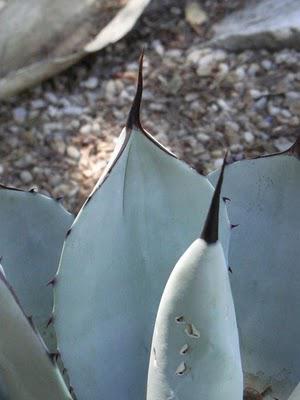 Some people just curl up with horror at cactus spines. I'm a moth to their flame.
Some people just curl up with horror at cactus spines. I'm a moth to their flame. 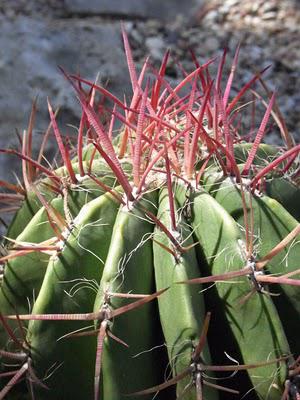 Yikes!
Yikes! 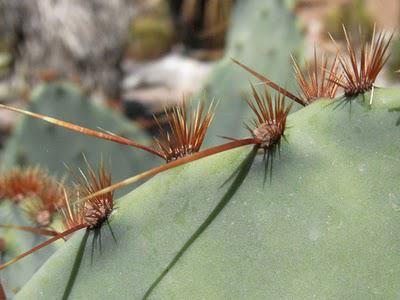 I see cacti as the little guy's friend. Anything big and dopey is jabbed and encouraged to rack off fast, while anything smaller than the spines can feel right at home. It's land rights for littlies, the ants and bugs and beetles, etc.
I see cacti as the little guy's friend. Anything big and dopey is jabbed and encouraged to rack off fast, while anything smaller than the spines can feel right at home. It's land rights for littlies, the ants and bugs and beetles, etc.That's enough spiny stuff. Onto some foliage, a few flowers and some pleasant surprises.
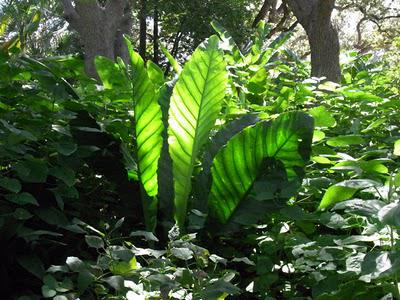 Broad leaves backlit by the sun, always a lovely sight.
Broad leaves backlit by the sun, always a lovely sight. In the more shaded spots the foliage colours stood out when next door to the bone-dry, sunburnt sunny spots.
In the more shaded spots the foliage colours stood out when next door to the bone-dry, sunburnt sunny spots. Another shade-lover shrugs off the drought.
Another shade-lover shrugs off the drought.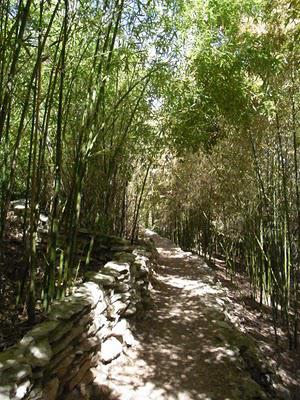 In the Japanese gardens the bamboo plantings were suffering from the lack of water, but the bamboo-lined walkways still had enough charm to look good.
In the Japanese gardens the bamboo plantings were suffering from the lack of water, but the bamboo-lined walkways still had enough charm to look good.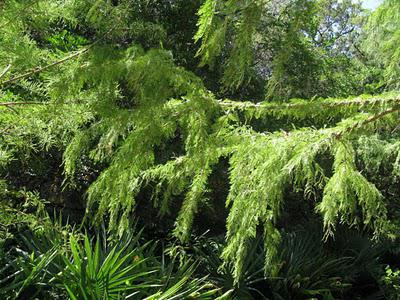 Many of the trees were visibly suffering from dryness, and even if the drought is broken they might not bounce back, but this Montezuma Cypress seemed unaffected, its very fine foliage a brilliant, healthy looking green.
Many of the trees were visibly suffering from dryness, and even if the drought is broken they might not bounce back, but this Montezuma Cypress seemed unaffected, its very fine foliage a brilliant, healthy looking green. Little pockets of flowers soldiered on in the shade and the semi-shade.
Little pockets of flowers soldiered on in the shade and the semi-shade.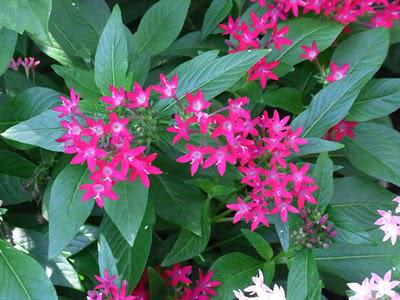 This is the red-flowered form of the pink one above.
This is the red-flowered form of the pink one above.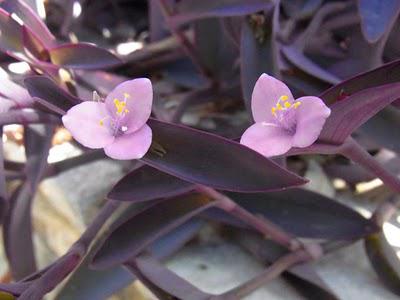 Flowers weren't plentiful, and so I had to flip the digital camera's switch to macro to get up close to these tiny and plentiful purple Tradescantia blooms.
Flowers weren't plentiful, and so I had to flip the digital camera's switch to macro to get up close to these tiny and plentiful purple Tradescantia blooms.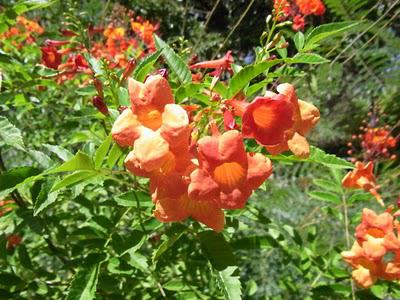 There were a few sun-loving plants in full sun that were blooming their head off, such as this orange dazzler and a purple-flowered, silver-foliaged local type of sage.
There were a few sun-loving plants in full sun that were blooming their head off, such as this orange dazzler and a purple-flowered, silver-foliaged local type of sage.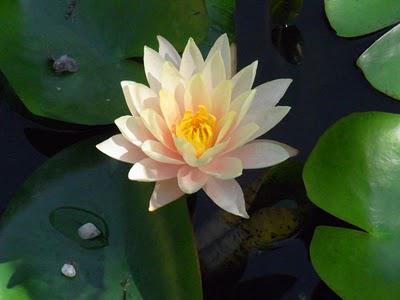 Severe local water restrictions mean that all the ponds, pools and waterfalls which are such a feature of these gardens were turned off. Several ponds were bone-dry, but a few have been allowed to soldier on to keep precious waterlilies and a big golden koi carp alive.
Severe local water restrictions mean that all the ponds, pools and waterfalls which are such a feature of these gardens were turned off. Several ponds were bone-dry, but a few have been allowed to soldier on to keep precious waterlilies and a big golden koi carp alive.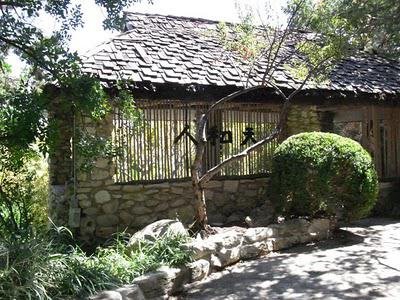 There's a Japanese garden here, and it's not at its best right now, as its water features are such a key part of the design. However, several bridges, arches and this lovely bamboo house provided a taste of what it must be like in its prime.
There's a Japanese garden here, and it's not at its best right now, as its water features are such a key part of the design. However, several bridges, arches and this lovely bamboo house provided a taste of what it must be like in its prime.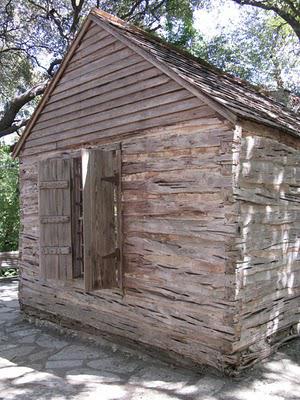 And it's not just Japanese structures which provide old-world charm. The Zilker includes a number of faithfully re-created buildings from the region's early days (such as this Swedish settler's hut, a tiny schoolhouse and a blacksmith's workshop). They're really well done, built in the rough yet practical way things were done in times long ago.
And it's not just Japanese structures which provide old-world charm. The Zilker includes a number of faithfully re-created buildings from the region's early days (such as this Swedish settler's hut, a tiny schoolhouse and a blacksmith's workshop). They're really well done, built in the rough yet practical way things were done in times long ago.Several times while wandering around the Zilker we spotted little squirrels darting about, but we couldn't get a good shot of them. Each time they'd spot us, scamper around to the 'blind' other side of the tree where we couldn't see them, then scamper up high, out of harm's way. Then, about 100 yards from our hotel room, as we passed by a park in the centre of the city, we ran into this guy.
 Fortunately I had my camera in hand and managed to bang off a couple of photos before the inevitable blind-side disappearing trick was performed yet again.
Fortunately I had my camera in hand and managed to bang off a couple of photos before the inevitable blind-side disappearing trick was performed yet again.I remember several years ago when I went out to see a long-anticipated singer perform, only to have him walk on stage and apologise that he had a sore throat and wouldn't be at his best that night. He still impressed and pleased us and we walked home thinking "how good would he sing if he was well!"
Well, it's the same with the Zilker Gardens. We've seen them probably at their worst, and we came home impressed enough. Here's hoping it rains real soon, Texas, rains a lot for a week or two at least, and that Austin and its gardens get their fair share.
